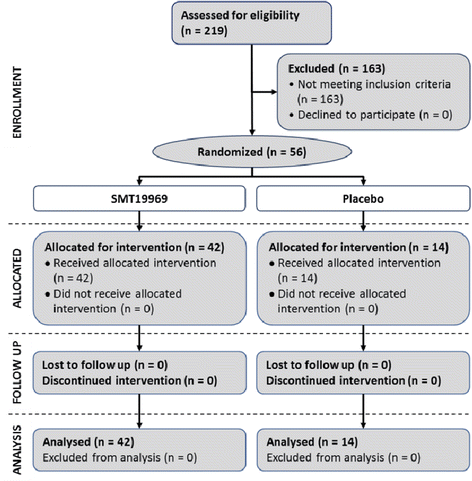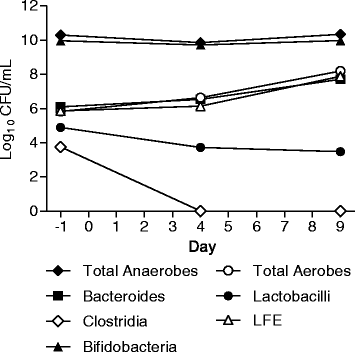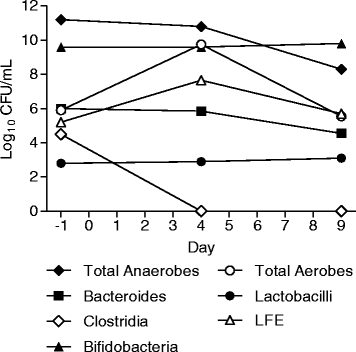A randomised phase 1 study to investigate safety, pharmacokinetics and impact on gut microbiota following single and multiple oral doses in healthy male subjects of SMT19969, a novel agent for Clostridium difficile infections
- PMID: 25880933
- PMCID: PMC4349307
- DOI: 10.1186/s12879-015-0759-5
A randomised phase 1 study to investigate safety, pharmacokinetics and impact on gut microbiota following single and multiple oral doses in healthy male subjects of SMT19969, a novel agent for Clostridium difficile infections
Abstract
Background: Clostridium difficile infection (CDI) is a leading cause of diarrhoea in health care settings with symptoms ranging from mild and self-limiting to life threatening. SMT19969 is a novel, non-absorbable antibiotic currently under development for the treatment of CDI. Here we report the results from a Phase I study.
Methods: A double-blind, randomized, placebo-controlled study assessing safety and tolerability of single and multiple oral doses of SMT19969 in healthy volunteers. Pharmacokinetic assessments included blood and faecal sampling. The effect of food on systemic exposure and analysis of the gut microbiota were also included.
Results: Fifty-six healthy male subjects were enrolled. Following single oral doses of up to 2,000 mg in the fasted state, plasma concentrations of SMT19969 were generally below the lower limit of quantification. In the fed state levels ranged from 0.102 to 0.296 ng/mL after single dosing and after repeat dosing at Day 10 from 0.105 to 0.305 ng/mL. Following single and multiple oral doses of SMT19969, mean daily faecal concentrations increased with increasing dose level and were significantly above the typical MIC range for C. difficile (0.06-0.5 μg/mL). At 200 mg BID, mean (± SD) faecal concentrations of 1,466 (±547) μg/g and 1,364 (±446) μg/g were determined on days 5 and 10 of dosing respectively. No notable metabolites were detected in faeces. Overall, all doses of SMT19969 were well tolerated both as single oral doses or BID oral doses for 10 days. The majority (88%) of adverse events (AEs) were classified as gastrointestinal disorders and were mild in severity, resolving without treatment. The gut microbiota was analysed in the multiple dose groups with minimal changes observed in the bacterial groups analysed except for total clostridia which were reduced to below the limit of detection by day 4 of dosing.
Conclusions: Oral administration of SMT19969 was considered safe and well tolerated and was associated with negligible plasma concentrations after single and multiple doses. In addition, minimal disruption of normal gut microbiota was noted, confirming the highly selective spectrum of the compound. These results support the further clinical development of SMT19969 as an oral therapy for CDI.
Trial registration: Current Controlled Trials. ISRCTN10858225 .
Figures



Similar articles
-
SMT19969 for Clostridium difficile infection (CDI): in vivo efficacy compared with fidaxomicin and vancomycin in the hamster model of CDI.J Antimicrob Chemother. 2015;70(6):1757-62. doi: 10.1093/jac/dkv005. Epub 2015 Feb 3. J Antimicrob Chemother. 2015. PMID: 25652749 Free PMC article.
-
Multiple-Ascending-Dose Phase 1 Clinical Study of the Safety, Tolerability, and Pharmacokinetics of CRS3123, a Narrow-Spectrum Agent with Minimal Disruption of Normal Gut Microbiota.Antimicrob Agents Chemother. 2019 Dec 20;64(1):e01395-19. doi: 10.1128/AAC.01395-19. Print 2019 Dec 20. Antimicrob Agents Chemother. 2019. PMID: 31685472 Free PMC article. Clinical Trial.
-
Ridinilazole: a novel therapy for Clostridium difficile infection.Int J Antimicrob Agents. 2016 Aug;48(2):137-43. doi: 10.1016/j.ijantimicag.2016.04.026. Epub 2016 May 30. Int J Antimicrob Agents. 2016. PMID: 27283730 Review.
-
Minimal systemic and high faecal exposure to cadazolid in patients with severe Clostridium difficile infection.Int J Antimicrob Agents. 2015 Nov;46(5):576-81. doi: 10.1016/j.ijantimicag.2015.07.015. Epub 2015 Sep 3. Int J Antimicrob Agents. 2015. PMID: 26419191 Clinical Trial.
-
SER-109 (VOWST™): A Review in the Prevention of Recurrent Clostridioides difficile Infection.Drugs. 2024 Mar;84(3):329-336. doi: 10.1007/s40265-024-02006-7. Epub 2024 Mar 5. Drugs. 2024. PMID: 38441806 Review.
Cited by
-
Susceptibility of Clostridium difficile Isolates of Varying Antimicrobial Resistance Phenotypes to SMT19969 and 11 Comparators.Antimicrob Agents Chemother. 2015 Nov 9;60(1):689-92. doi: 10.1128/AAC.02000-15. Print 2016 Jan. Antimicrob Agents Chemother. 2015. PMID: 26552981 Free PMC article.
-
Effect of Bifidobacterium upon Clostridium difficile Growth and Toxicity When Co-cultured in Different Prebiotic Substrates.Front Microbiol. 2016 May 18;7:738. doi: 10.3389/fmicb.2016.00738. eCollection 2016. Front Microbiol. 2016. PMID: 27242753 Free PMC article.
-
Updates in Treatment of Recurrent Clostridium difficile Infection.J Clin Med Res. 2019 Jul;11(7):465-471. doi: 10.14740/jocmr3854. Epub 2019 Jun 11. J Clin Med Res. 2019. PMID: 31236163 Free PMC article. Review.
-
Management of adult Clostridium difficile digestive contaminations: a literature review.Eur J Clin Microbiol Infect Dis. 2019 Feb;38(2):209-231. doi: 10.1007/s10096-018-3419-z. Epub 2018 Nov 29. Eur J Clin Microbiol Infect Dis. 2019. PMID: 30498879 Review.
-
Antimicrobial susceptibility and ribotypes of Clostridium difficile isolates from a Phase 2 clinical trial of ridinilazole (SMT19969) and vancomycin.J Antimicrob Chemother. 2018 Aug 1;73(8):2078-2084. doi: 10.1093/jac/dky135. J Antimicrob Chemother. 2018. PMID: 29718329 Free PMC article. Clinical Trial.
References
Publication types
MeSH terms
Substances
Associated data
Grants and funding
LinkOut - more resources
Full Text Sources
Other Literature Sources
Medical

